Table of Contents
- Introduction
- Editor’s Choice
- Wound Care Market Overview
- Active Wound Care Market Overview
- Advanced Wound Care Market Overview
- Burn Care Market Overview
- First Aid Kit Sales Statistics and Trends – By Category
- First Aid Kit Sales Statistics and Trends
- OTC Sales of First Aid Products Statistics
- First Aid Tape/Bandage Sales Statistics and Trends
- Sales Growth of First Aid Products Statistics
- Price of Various First Aid Products Statistics
- Key Spending and Investments
- First Aid Regulations
- Recent Developments
- Conclusion
- FAQs
Introduction
First Aid Statistics: First aid is the immediate assistance provided to individuals experiencing medical emergencies, aimed at preserving life. Preventing further injury, and promoting recovery until professional help arrives.
Key components include assessing the situation and the victim’s responsiveness. Performing a primary survey (checking airway, breathing, and circulation), and providing necessary care such as CPR, choking relief, and wound management.
After addressing immediate threats, a secondary survey may identify additional injuries and professional help should be sought if needed.
Training in first aid, including certification programs from organizations like the American Red Cross. It is crucial for preparedness in emergencies, ultimately enhancing community resilience and safety.
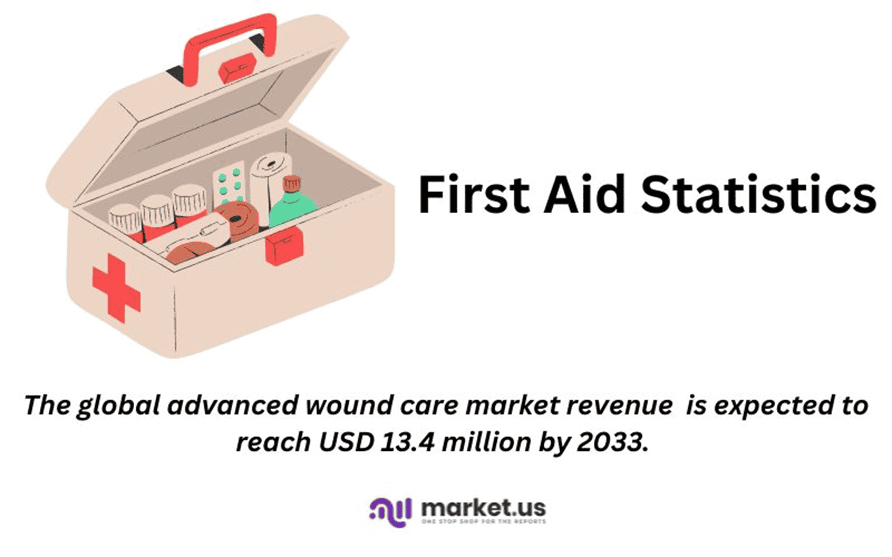
Editor’s Choice
- The global advanced wound care market revenue is expected to reach USD 13.4 million by 2033.
- The sales value of first-aid boxes and kits by manufacturers in the United Kingdom reached £12,000 in 2018.
- In 2019, the sales of first aid accessories in the United States varied significantly across different categories. Reflecting diverse consumer needs and preferences. The tape, bandage, gauze, and cotton category led to the highest sales. Reaching USD 918.74 million, indicating robust demand for basic wound care supplies.
- In 2019, the unit sales of various first aid tape, bandage, gauze, and cotton brands in the United States showcased a mix of established brands and private labels dominating the market. Private label products led the market significantly, with 113.6 million units sold, highlighting consumer preference for cost-effective alternatives.
- In 2019, the dollar sales growth for first aid accessories in the United States showed varying trends across different categories compared to the previous year. First aid kits led the growth with a significant increase of 7.40%. Indicating strong consumer demand for comprehensive and ready-to-use emergency solutions.
- In 2014, the average prices per unit of various first aid products in the United States varied across different categories. Reflecting the diverse needs and manufacturing costs associated with each type of product. Muscle and body support devices commanded the highest average price at USD 10.08 per unit.
- In the UK, the Health and Safety (First-Aid) Regulations 1981 require all employers to provide adequate first-aid equipment, facilities, and personnel. Adjusted based on a thorough assessment of first aid needs that considers the specific circumstances of the workplace.
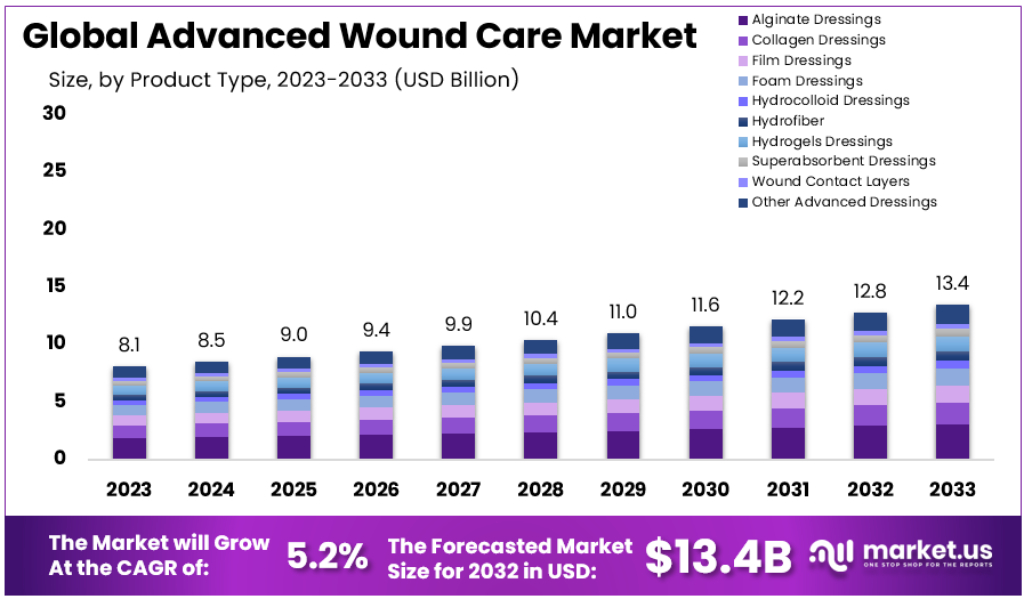
Wound Care Market Overview
Global Wound Care Market Size
- The global wound care market has demonstrated steady growth from 2016 to 2029 at a CAGR of 0.40%.
- The market size was valued at USD 3.22 billion in 2016, with a slight increase to USD 3.23 billion in 2017.
- It continued to grow marginally, reaching USD 3.27 billion in 2018 and USD 3.29 billion in 2019.
- The market size remained stable at USD 3.29 billion in 2020, likely influenced by global economic conditions.
- A gradual increase was observed in subsequent years, with the market size reaching USD 3.35 billion in 2021, USD 3.39 billion in 2022, and USD 3.42 billion in 2023.
- The growth trajectory is expected to continue, with the market projected to increase to USD 3.44 billion by 2024, USD 3.47 billion by 2025, and USD 3.48 billion by 2026.
- A more modest growth is forecasted for the following years, with the market size reaching USD 3.50 billion in 2027 and plateauing at USD 3.51 billion by 2028, maintaining through 2029.
- This consistent growth underscores the increasing demand for wound care products and services globally.
(Source: Statista)

Global Wound Care Market Revenue Change
- The annual percentage changes in the global wound care market revenue from 2017 to 2029 reflect a general trend of moderate growth, interspersed with a temporary setback.
- In 2017, the market experienced a modest increase of 0.5%.
- This was followed by a stronger performance in 2018, with revenue growth of 1.1%.
- The growth continued, albeit at a slightly reduced pace, with an increase of 0.8% in 2019.
- A slight decline was observed in 2020, with a decrease of 0.2%, likely impacted by global economic factors.
- However, the market rebounded significantly in 2021, witnessing a growth of 1.8%.
- This upward trend persisted, with an increase of 1.1% in 2022 and 1.0% in 2023.
- From 2024 onwards, the growth rates showed a gradual decrease: 0.8% in 2024, 0.6% in 2025, and 0.5% in 2026.
- The subsequent years saw further moderation in growth, with the market revenue growing by 0.4% in 2027, 0.3% in 2028, and finally tapering off to a minimal increase of 0.2% in 2029.
- This progression indicates a stabilization of the market with decreasing growth increments over time.
(Source: Statista)
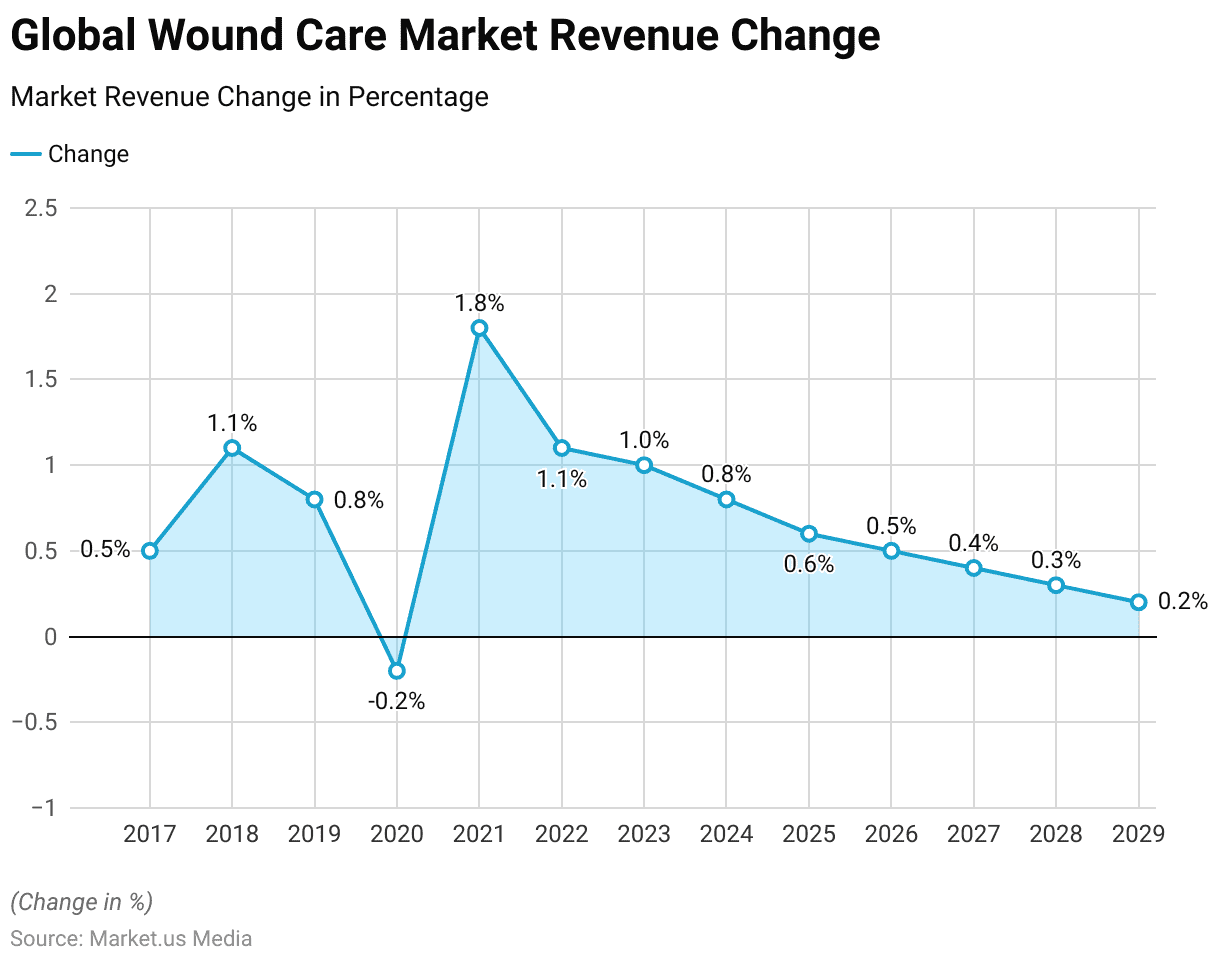
Wound Care Market Revenue – By Country
- The wound care market revenue by country showcases a range of values, with the United States leading significantly at USD 1,052 million.
- China follows with a revenue of USD 213.50 million. Closely trailed by Japan at USD 208.90 million and Italy at USD 194.20 million.
- Germany also has a strong market presence, with revenues amounting to USD 191.50 million.
- France’s wound care market stands at USD 151.90 million, while Australia’s market is somewhat smaller at USD 110.50 million.
- Canada and Russia report revenues of USD 88.17 million and USD 85.66 million, respectively.
- The United Kingdom has a market size of USD 72.26 million. Followed by the Netherlands at USD 66.89 million and South Korea at USD 61.16 million.
- Further down the list, India’s market revenue is reported at USD 49.01 million. Slightly above Brazil at USD 47.88 million, and Poland rounds out the group with USD 41.50 million.
- These figures indicate a diverse global landscape in wound care market revenues, with significant variances among different countries.
(Source: Statista)
Take advantage of our unbeatable offer - buy now!

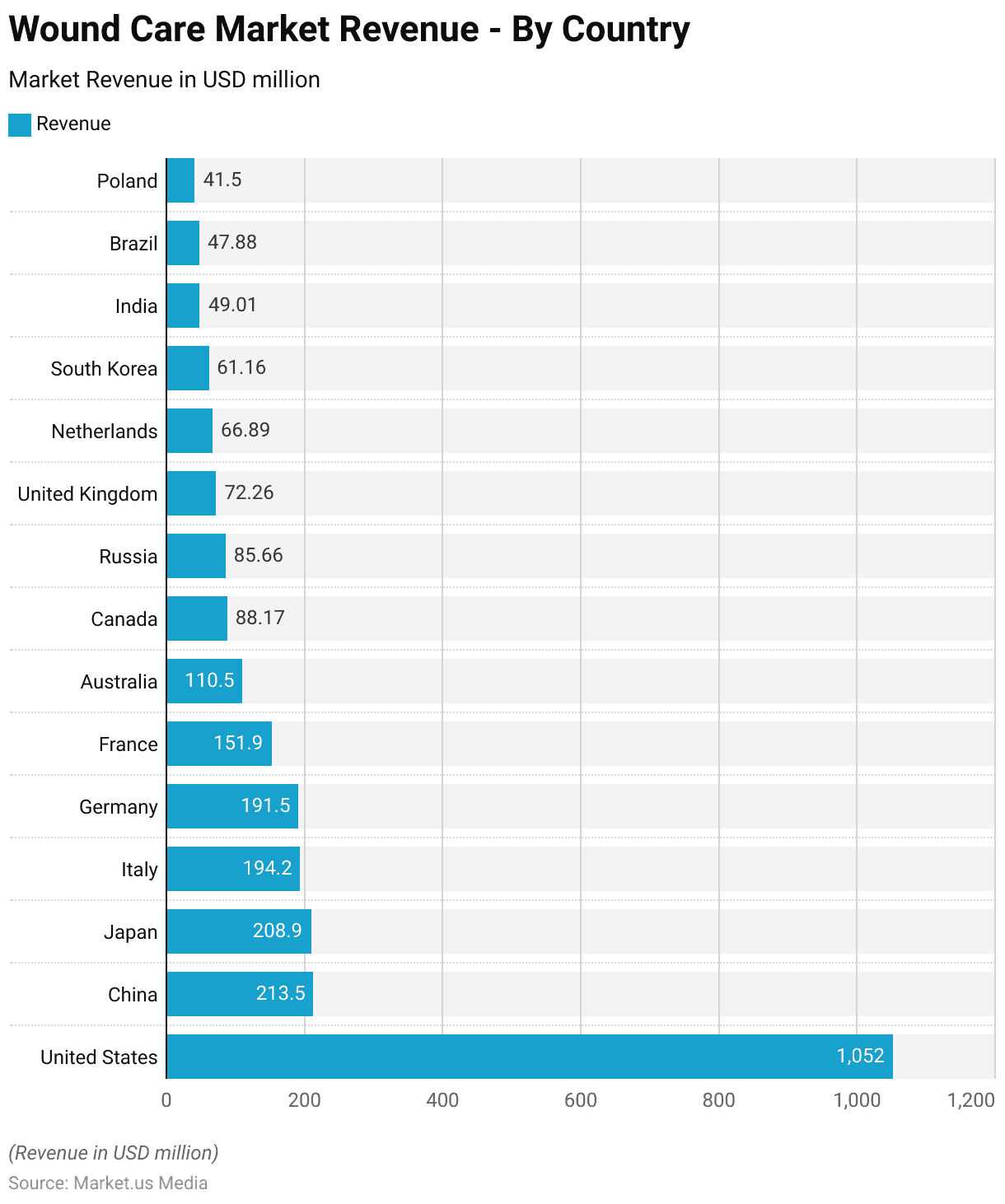
Active Wound Care Market Overview
Global Active Wound Care Market Size
- The global active wound care market is projected to grow consistently over the period from 2022 to 2032 at a CAGR of 5.5%.
- The market size began at USD 1,137 million in 2022 and showed a steady increase to USD 1,200 million by 2023.
- It continued its upward trend, reaching USD 1,257 million in 2024.
- A more substantial increase was observed by 2025 when the market size expanded to USD 1,344 million.
- The growth persisted, with the market size reaching USD 1,428 million in 2026 and USD 1,496 million in 2027.
- By 2028, the market size slightly increased to USD 1,547 million. Followed by a more notable rise to USD 1,632 million in 2029.
- The market continued to grow, reaching USD 1,710 million in 2030, USD 1,804 million in 2031, and finally peaking at USD 1,916 million by 2032.
- This steady growth trajectory reflects an increasing recognition of the effectiveness of active wound care products and their expanding applications in medical treatment protocols.
(Source: market.us)
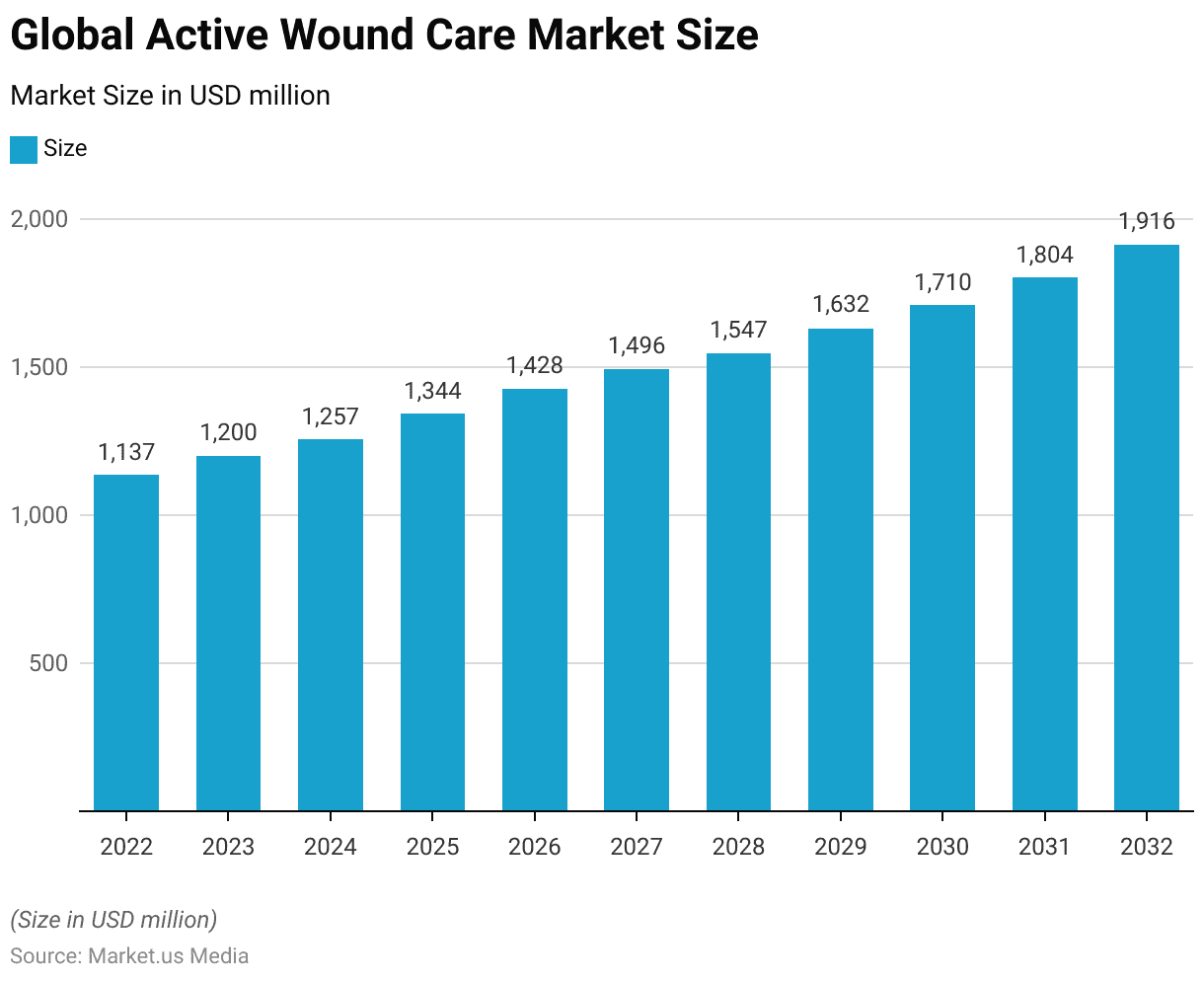
Advanced Wound Care Market Overview
Global Advanced Wound Care Market Size
- The global advanced wound care market is expected to exhibit a steady increase in market size from 2023 to 2033 at a CAGR of 5.2%.
- Starting at USD 8.1 million in 2023, the market size is projected to grow gradually to USD 8.5 million in 2024.
- Further increases are forecasted, with the market reaching USD 9.0 million in 2025 and continuing to rise to USD 9.4 million in 2026.
- By 2027, the market size is anticipated to be USD 9.9 million, and it will slightly increase to USD 10.4 million in 2028.
- The growth momentum is maintained through the end of the decade. Reaching USD 11.0 million in 2029 and USD 11.6 million in 2030.
- The upward trend is expected to continue into the early 2030s, with the market size reaching USD 12.2 million in 2031, USD 12.8 million in 2032, and concluding at USD 13.4 million by 2033.
- This steady growth highlights the ongoing advancements and increasing demand for innovative wound care solutions globally.
(Source: market.us)
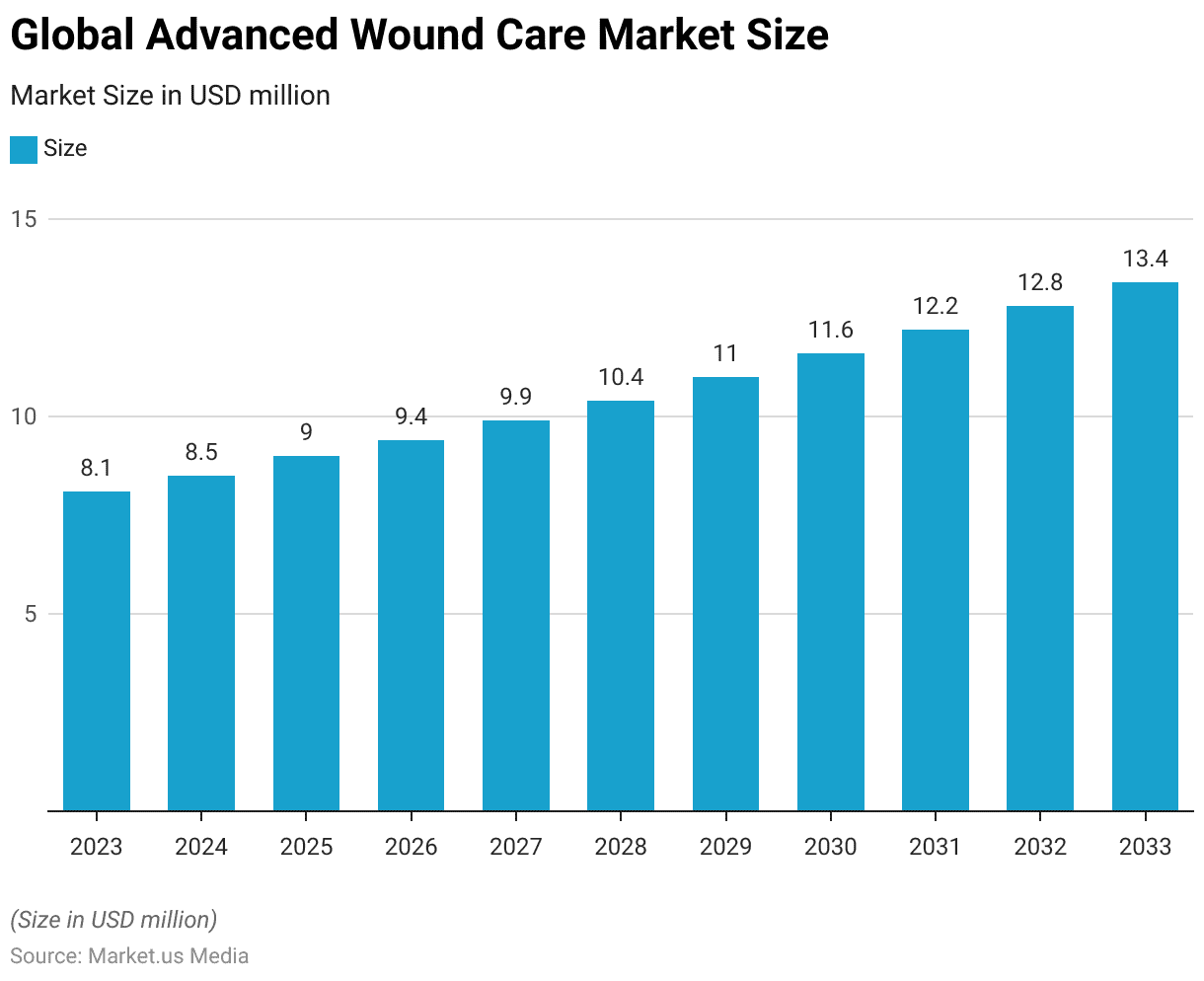
Global Advanced Wound Management Market Share – By Company
- In 2023, the distribution of market shares within the global advanced wound management sector presents a diverse competitive landscape.
- 3M leads with a market share of 16%, closely followed by Smith & Nephew, which holds 14% of the market.
- Moinlycte also holds a significant portion, commanding 10% of the market.
- Convatec is another key player, albeit with a smaller share of 6%.
- The majority of the market, however, is comprised of various other companies, collectively accounting for 54% of the market share.
- This segmentation indicates a robust competitive environment where a large portion of the market is still up for grabs by both established and emerging companies within the industry.
(Source: Statista)
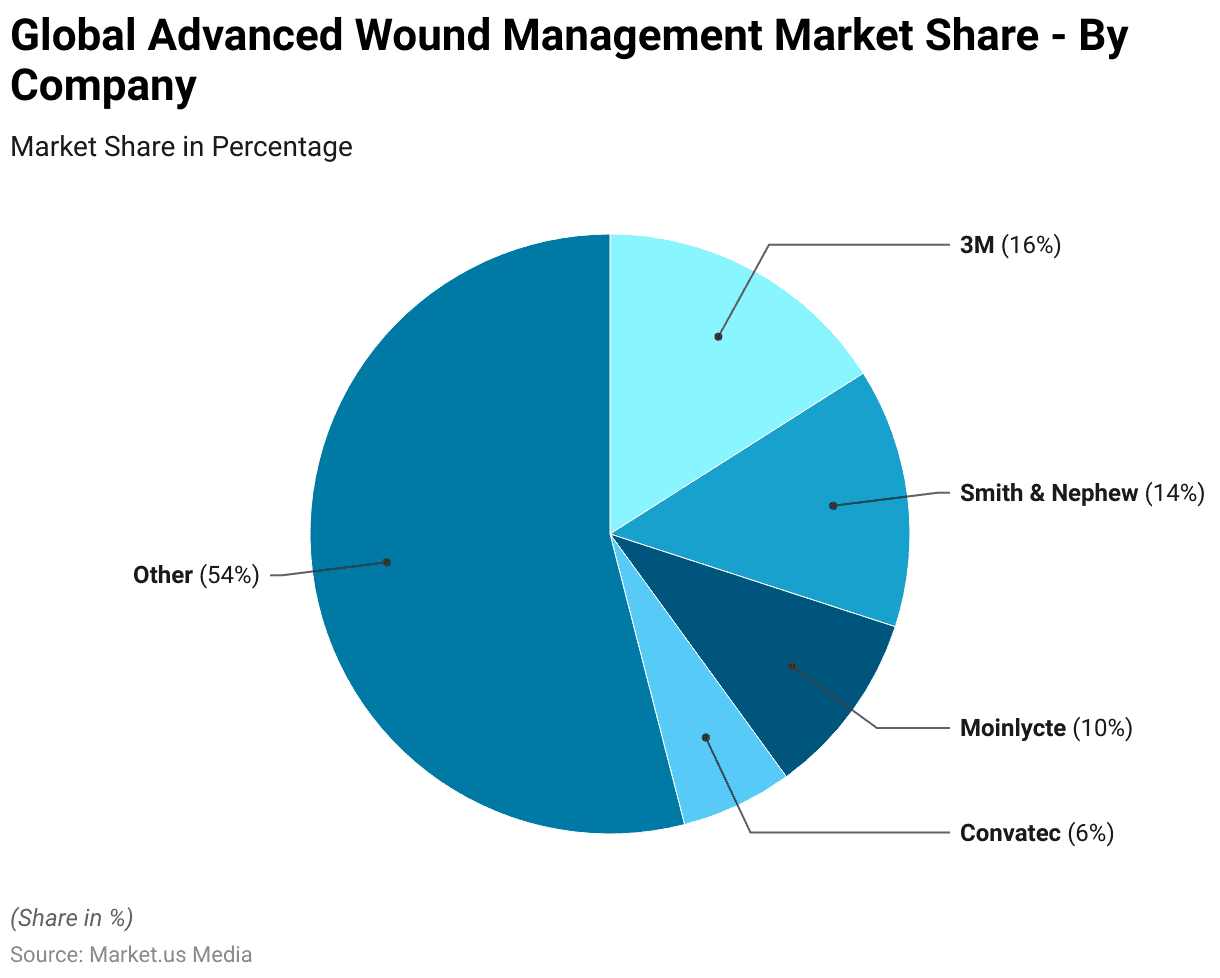
Burn Care Market Overview
Global Burn Care Market Size
- The global burn care market is projected to experience significant growth from 2022 to 2032 at a CAGR of 8.5%.
- Starting with a market size of USD 2.73 billion in 2022, it is anticipated to increase steadily to USD 2.96 billion by 2023.
- The following year, 2024, sees a further rise to USD 3.21 billion.
- The growth trajectory continues, with the market reaching USD 3.49 billion in 2025, USD 3.78 billion in 2026, and USD 4.10 billion in 2027.
- The upward trend persists into the late 2020s, with market sizes of USD 4.45 billion in 2028 and USD 4.83 billion in 2029.
- Entering the next decade, the market is expected to expand to USD 5.24 billion in 2030. Followed by an increase to USD 5.69 billion in 2031, culminating at USD 6.17 billion by 2032.
- This consistent growth underscores an expanding demand within the burn care sector. Driven by advancements in treatment and an increasing global awareness of burn care necessities.
(Source: market.us)

First Aid Kit Sales Statistics and Trends – By Category
First Aid Accessory Sales in the United States – By Category Statistics
- In 2019, the sales of first aid accessories in the United States varied significantly across different categories, reflecting diverse consumer needs and preferences.
- The tape, bandage, gauze, and cotton category led to the highest sales. Reaching USD 918.74 million, indicating robust demand for basic wound care supplies.
- Muscle and body support devices also saw substantial sales, amounting to USD 800.79 million. Underscoring their importance in injury prevention and recovery.
- Heat and ice packs are used for treating injuries and relieving pain. Generated USD 256.14 million in sales, reflecting their essential role in both home and sports environments.
- First aid kits, which package these essential items together. Contributed USD 58.58 million to the sales figures, highlighting their utility in emergency preparedness.
- Lastly, electrotherapy devices, which are used for pain management and muscle stimulation, accounted for USD 43.91 million in sales. Pointing to a growing consumer interest in advanced therapeutic options.
- This distribution of sales demonstrates the varied applications and consumer reliance on first aid and recovery products in everyday life.
(Source: Statista)

Unit Sales of First Aid Treatment in the United States – By Category Statistics
- In 2019, the unit sales of first-aid treatment products in the United States highlighted significant consumer usage across various categories.
- Leading the sales were first aid ointments and antiseptics, which sold 253.39 million units, reflecting their essential role in basic wound care and infection prevention.
- Anti-itch treatments, including calamine lotions, also saw robust sales, totaling 90.68 million units, indicating widespread use for relieving discomfort from insect bites, rashes, and other skin irritations.
- Further down the list, insect first aid products, specifically designed to address bites and stings, accounted for 4.06 million units.
- This demonstrates a niche but important demand within the broader first aid category.
- Lastly, smelling salts, used traditionally to revive or stimulate consciousness, recorded the smallest sales volume at 0.53 million units, showcasing their limited but specific application in medical and emergency response scenarios.
- This breakdown of sales underscores the diversity in first-aid treatment preferences and needs among U.S. consumers.
(Source: Statista)
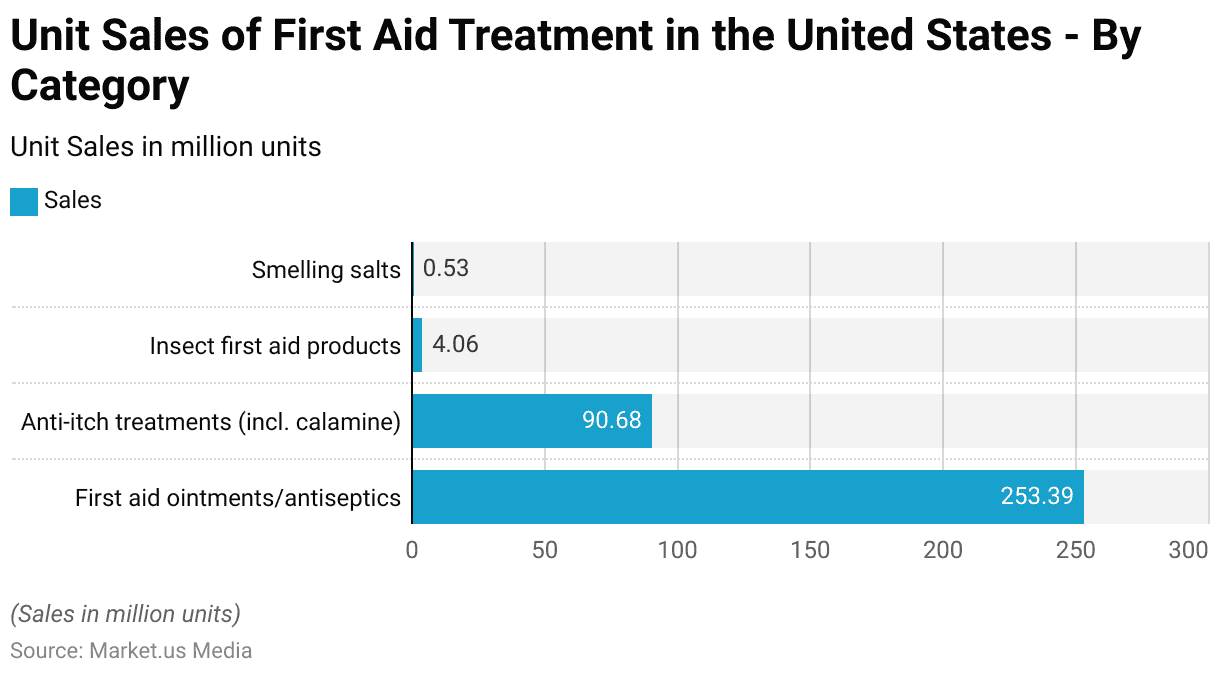
Unit Sales of Private Label First Aid Products in the United States – By Category Statistics
- In 2014, the unit sales of private-label first aid products in the United States were distributed across several key categories.
- First aid ointments and antiseptics led the segment, selling 134.8 million units, highlighting their crucial role in home and professional healthcare settings for treating minor wounds and preventing infections.
- Tape, bandage, gauze, and cotton followed with substantial sales of 88.2 million units, emphasizing their widespread use in injury management and wound care.
- Anti-itch treatments, including calamine, accounted for 28.4 million units, underscoring their importance in providing relief from skin irritations and allergic reactions.
- Muscle and body support devices, used to stabilize and support injuries, sold 20.4 million units, reflecting their utility in sports and physical therapy.
- Lastly, heat and ice packs, essential for pain relief and swelling reduction, recorded sales of 11.1 million units, indicating their steady demand for both immediate first aid and ongoing injury management.
- These figures demonstrate a strong market presence of private-label products in various first aid categories, offering accessible and cost-effective solutions for a range of healthcare needs.
(Source: Statista)
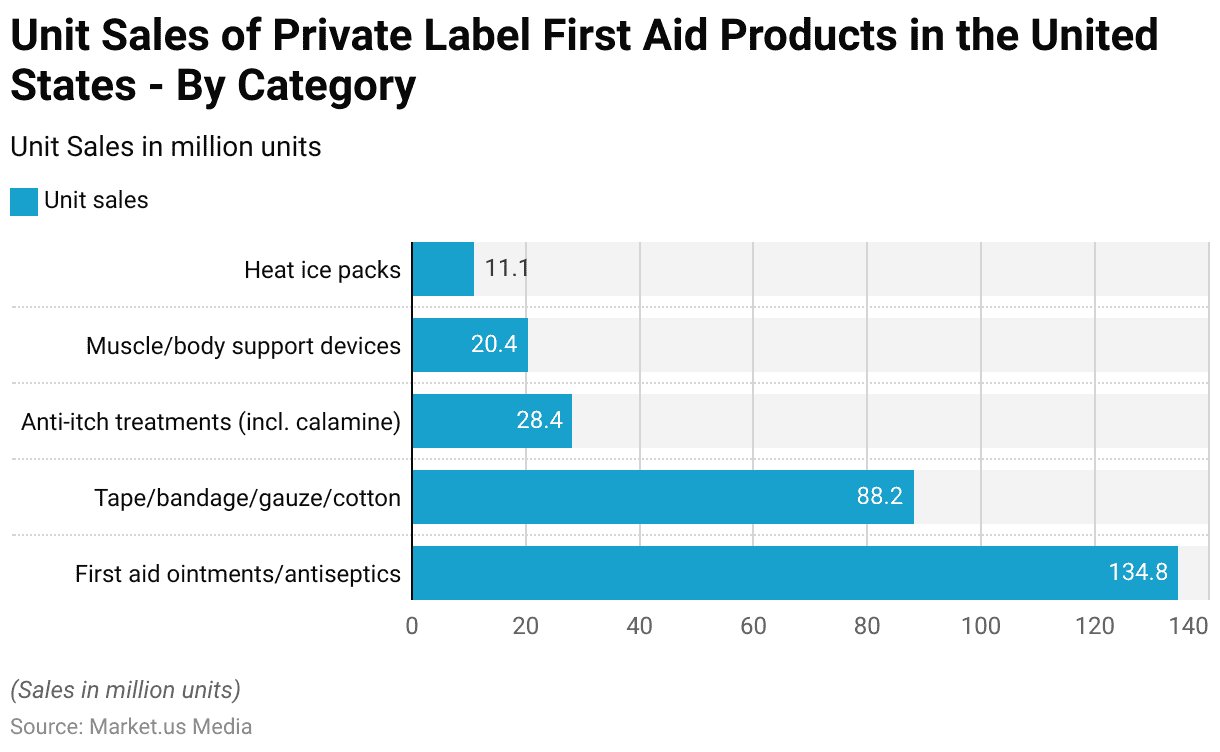
First Aid Kit Sales Statistics and Trends
First Aid Kits Sales Value in the United Kingdom (UK) Statistics
- From 2010 to 2018, the sales value of first-aid boxes and kits by manufacturers in the United Kingdom exhibited a fluctuating trend.
- In 2010, sales started at £55,000 but saw a significant drop to £25,000 in 2011.
- Sales partially recovered to £43,000 in 2012 and peaked at £60,000 in 2013.
- However, a decline followed, with sales falling to £42,000 in 2014, then sharply to £24,000 in 2015.
- The downward trajectory continued, with sales decreasing further to £16,000 in 2016 and reaching a low of £12,000 by 2018.
- This pattern indicates a notable decrease in the market demand or competitive shifts in the UK market for first-aid kits over the given period.
(Source: Statista)

Unit Sales of the Leading First Aid Kit Brands in the United States Statistics
- In 2018, the unit sales of the leading first aid kit brands in the United States presented a diverse marketplace.
- Private label brands led the market with significant sales, reaching 2,411.5 thousand units.
- Johnson & Johnson also had a strong presence, with their general offerings selling 1,009.9 thousand units and their specific products, “Red Cross First Aid to Go!” and “Red Cross Safe Travels,” selling 3,008.9 thousand units and 157.2 thousand units, respectively.
- No brand items accounted for 611.6 thousand units, illustrating substantial demand for non-branded kits.
- Other notable entries included Get Smart Get Prepared, which sold 355.8 thousand units, and First Aid Plus, which sold 241.1 thousand units.
- Specialty brands like Easy Care First Aid and Adventure Medical Kits recorded lower sales figures at 45.4 thousand and 105.5 thousand units, respectively.
- Lifeline rounded off the list with 39.9 thousand units sold.
- This varied brand performance highlights differing consumer preferences and brand loyalties in the U.S. first aid kit market.
(Source: Statista)

OTC Sales of First Aid Products Statistics
First Aid OTC Revenue in the United States Statistics
- The revenue from over-the-counter (OTC) first aid products in the United States displayed a notable growth trend from 2017 to 2023, with a significant peak during 2020.
- The revenue started at USD 1,268 million in 2017 and experienced a mild increase to USD 1,279 million in 2018.
- The growth continued at a steady pace, reaching USD 1,308 million in 2019.
- A substantial jump in revenue occurred in 2020, with figures soaring to USD 1,590 million, likely due to increased demand during the global health crisis.
- However, this spike was followed by a decrease to USD 1,543 million in 2021 and further to USD 1,515 million in 2022, indicating a normalization of market conditions post-peak.
- In 2023, the revenue saw a recovery to USD 1,595 million, suggesting a resurgence in demand or adjustments in market strategies to elevate sales.
- This trajectory reflects the dynamic nature of the OTC first aid products market in response to external health events and economic conditions.
(Source: Statista)

First Aid Products OTC Sales Volume in the United States Statistics
- The sales volume of over-the-counter first aid products in the United States exhibited a general upward trend from 2011 to 2023, with some fluctuations in recent years.
- In 2011, sales volumes were recorded at 293 million units.
- This figure saw a steady increase over the subsequent years, rising to 306 million units in 2012, 311 million units in 2013, 319 million units in 2014, and reaching 327 million units by 2015.
- The growth continued with sales hitting 333 million units in 2016, then leveling out at 340 million units for both 2017 and 2018.
- A marginal increase occurred in 2019, with 341 million units sold.
- A significant surge was observed in 2020 when sales volumes jumped to 421 million units, possibly influenced by heightened health awareness and preparedness during the global health events of that year.
- However, the sales volume receded to 372 million units in 2021, followed by a further reduction to 328 million units in 2022 and slightly down to 325 million units in 2023.
- This trajectory indicates varied consumer behavior and market dynamics influencing the demand for first aid products across the period.
(Source: Statista)

First Aid Tape/Bandage Sales Statistics and Trends
Unit Sales of the Leading First Aid Tape/Bandage/Gauze/Cotton Brands in the United States Statistics
- In 2019, the unit sales of various first aid tape, bandage, gauze, and cotton brands in the United States showcased a mix of established brands and private labels dominating the market.
- Private label products led the market significantly, with 113.6 million units sold, highlighting consumer preference for cost-effective alternatives.
- Band-Aid was a strong competitor, with its products selling 42.1 million units.
- 3M Nexcare also had notable sales, recording 17.7 million units, while Band-Aid Tough Strips accounted for 14.7 million units.
- Additional products from Johnson & Johnson’s Red Cross line included 7.9 million units, with their specific product, Johnson & Johnson Red Cross Band-Aid, further contributing 4.3 million units.
- Band-Aid Skin Flex sold 6.2 million units, indicating a preference for specialized products within the same brand umbrella.
- Other brands, such as New Skin and Rexall, had sales of 3.2 million units and 6.3 million units, respectively. In contrast, 3M Nexcare Tegaderm, a more specialized product, had lower sales at 1.2 million units.
- This distribution highlights the diverse consumer choices in the segment, ranging from basic care items to more specialized wound care solutions.
(Source: Statista)

Dollar Sales Share of the Leading First Aid Tape/Bandage/Gauze/Cotton Brands in the United States Statistics
- In 2019, the dollar sales share of the leading first aid tape, bandage, gauze, and cotton brands in the United States revealed a market heavily influenced by private label products, which commanded a dominant 42.60% share, underscoring their appeal due to competitive pricing and broad availability.
- Band-Aid maintained a strong presence as well, securing 18.80% of the sales share.
- 3M Nexcare also made a significant impact with a 7.60% share, followed closely by Band-Aid Tough Strips at 6.80%.
- Johnson & Johnson’s Red Cross products captured a 3.40% share, while Band-Aid Skin Flex garnered 2.70%.
- Their specialized product, Johnson & Johnson Red Cross Band-Aid, held a 2.00% share, illustrating a niche but stable market position.
- New Skin and Rexall each represented smaller segments of the market at 1.70% and 1.50%, respectively.
- Similarly, 3M Nexcare Tegaderm, tailored for specific consumer needs, also held a 1.50% share.
- This distribution highlights a market that values both brand recognition and cost-effectiveness across various consumer segments.
(Source: Statista)

Sales Growth of First Aid Products Statistics
Sales Growth of the Leading First Aid Tape/Bandage/Gauze/Cotton Brands in the United States Statistics
- In 2019, the sales growth figures for leading first aid tape, bandage, gauze, and cotton brands in the United States presented a mixed landscape.
- Private label brands and Band-Aid showed positive growth, with increases of 5% and 5.40%, respectively. Suggesting strong consumer trust and consistent demand.
- 3M Nexcare also experienced a growth of 2.60%. While 3M Nexcare Tegaderm grew by 3.80%, indicating steady market acceptance.
- Conversely, several brands faced declines. Band-Aid Tough Strips saw a decrease of 7.50%, Johnson & Johnson Red Cross experienced a significant drop of 13.70%, and Band-Aid Skin Flex decreased by 8.90%. Reflecting possibly shifting consumer preferences or increased competition.
- However, Johnson & Johnson Red Cross Band-Aid was an exception within the company. Posting an increase of 8.70%, highlighting specific product strength despite broader challenges.
- Other brands like New Skin and Rexall also saw declines in their sales by 1.60% and 3.60%, respectively, pointing to tough market conditions for certain products.
- This diversity in sales performance underscores the dynamic and competitive nature of the market in first aid products.
(Source: Statista)
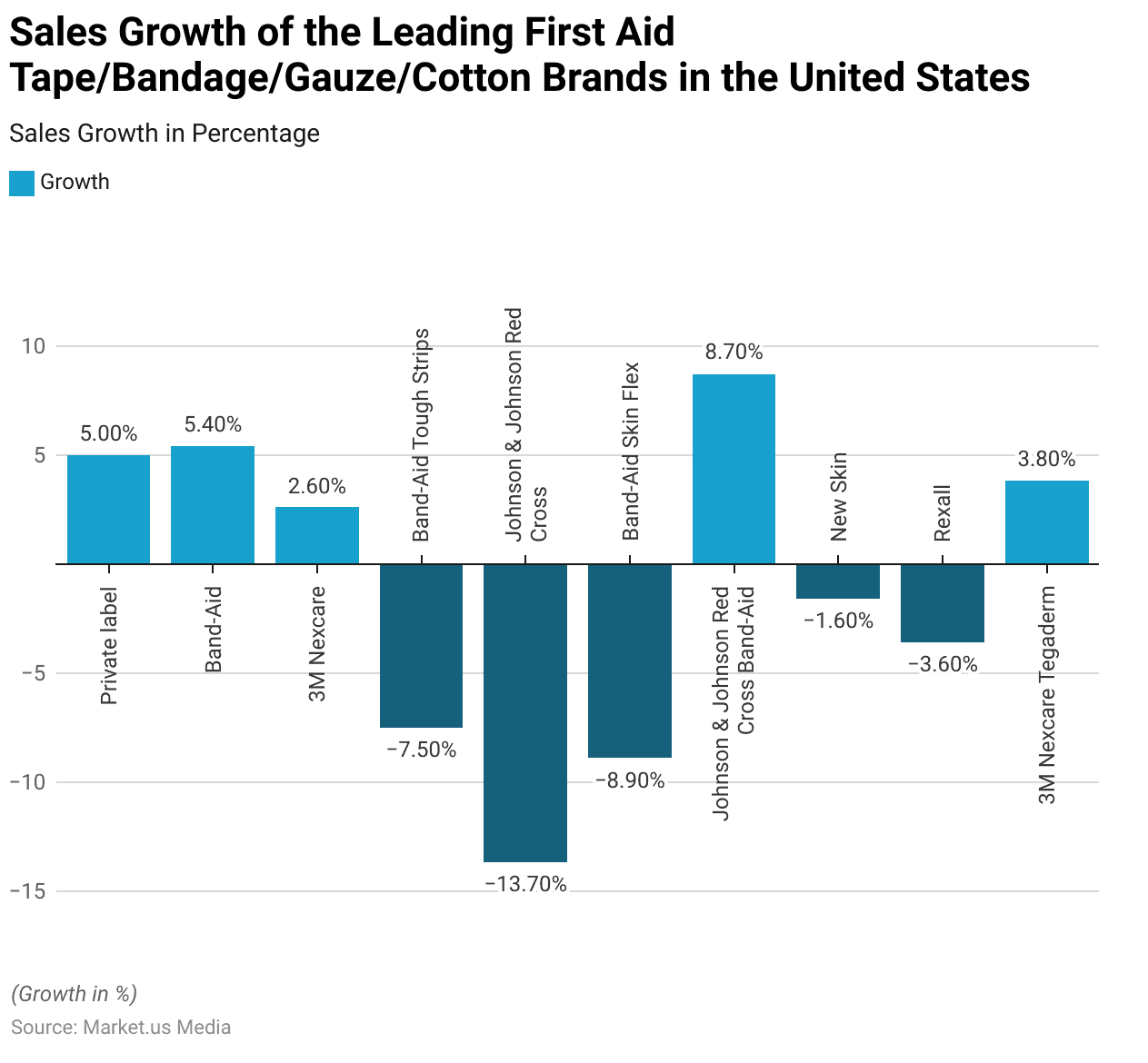
Dollar Sales Growth of First Aid Treatment in the United States – By Category Statistics
- In 2019, the dollar sales growth of various first-aid treatment categories in the United States indicated differing levels of market dynamics compared to the previous year.
- Insect first aid products experienced the highest growth at 1.20%. This reflects increased consumer demand potentially due to seasonal factors or heightened awareness of outdoor activities.
- Anti-itch treatments, including products such as calamine lotion, also saw a positive growth of 0.80%. Suggesting continued reliance on these treatments for skin irritations and allergies.
- First aid ointments and antiseptics showed a modest increase of 0.20%, indicating stable but slow growth in this essential category.
- In contrast, smelling salts witnessed a decline in sales, dropping by 4.80%. This could indicate a decreasing use in medical or emergency settings or a shift towards alternative products for revival and stimulation purposes.
- These figures illustrate varied consumer behaviors and trends within the first-aid treatment market.
(Source: Statista)
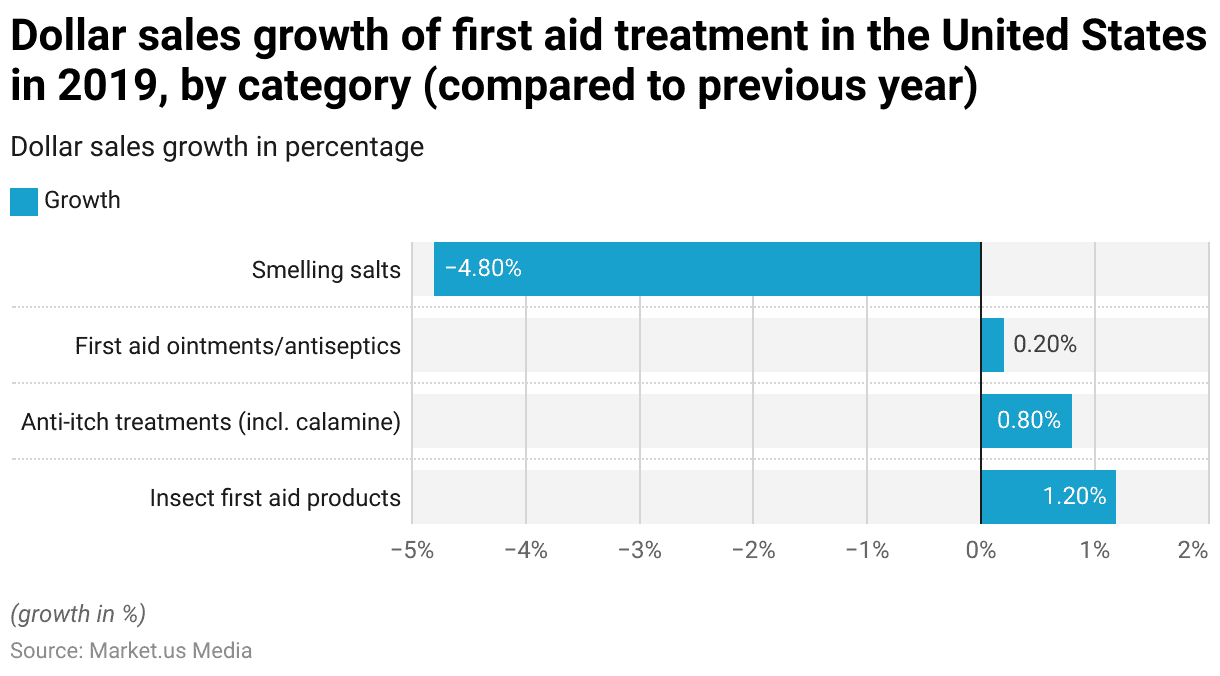
Dollar Sales Growth of First Aid Accessories in the United States – By Category Statistics
- In 2019, the dollar sales growth for first aid accessories in the United States showed varying trends across different categories compared to the previous year.
- First aid kits led the growth with a significant increase of 7.40%. Indicating strong consumer demand for comprehensive and ready-to-use emergency solutions.
- Heat/ice packs followed with a healthy growth rate of 6%. Underscoring their continued importance in pain management and injury treatment.
- Muscle and body support devices also experienced positive growth, rising by 4.20%, reflecting a growing consumer focus on physical support and rehabilitation.
- Tape, bandage, gauze, and cotton products saw a growth of 3.80%. Demonstrating ongoing necessity in basic wound care and management. In stark contrast, electrotherapy devices faced a substantial decrease in dollar sales growth, plummeting by 26.90%.
- This decline could suggest a shift in consumer preference away from these devices or possibly greater market competition or advancements in alternative pain management technologies.
- These trends highlight different consumer priorities and market shifts within the first aid accessories sector.
(Source: Statista)
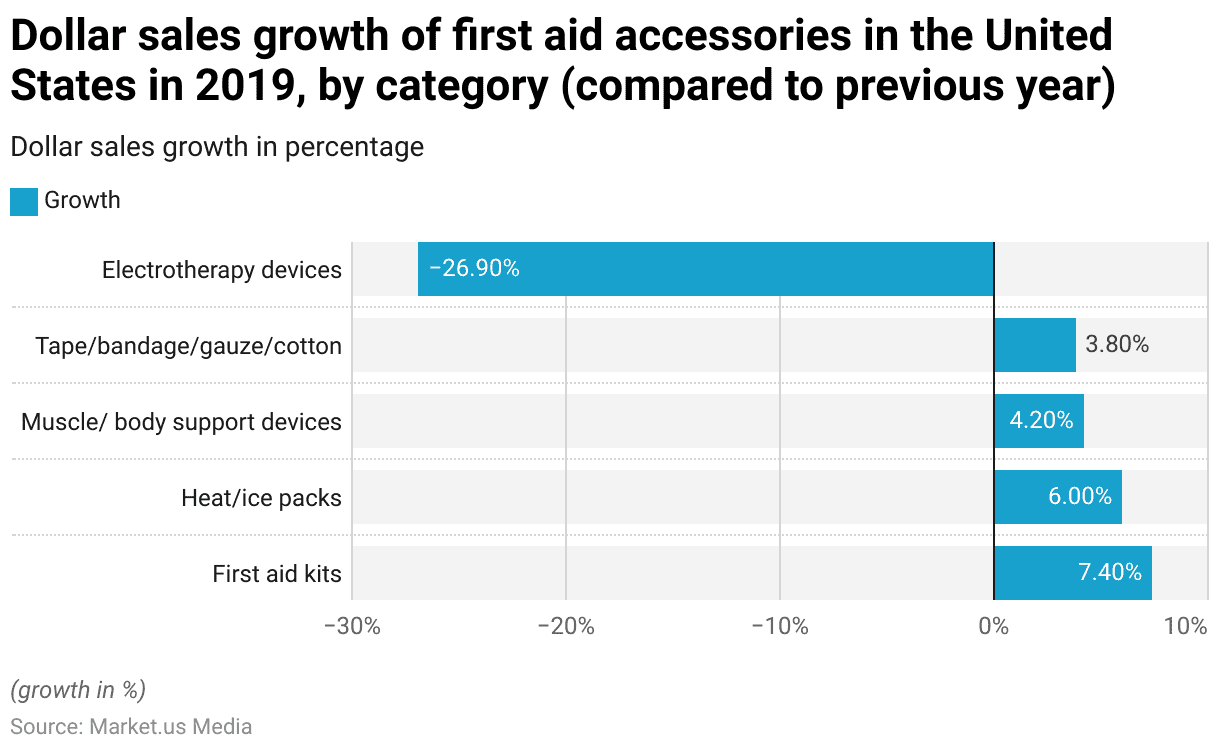
Price of Various First Aid Products Statistics
Price of First Aid Products Statistics
- In 2014, the average prices per unit of various first aid products in the United States varied across different categories. Reflecting the diverse needs and manufacturing costs associated with each type of product.
- Muscle and body support devices commanded the highest average price at USD 10.08 per unit. Indicative of the specialized materials and design required for effective support and stabilization.
- Anti-itch treatments, including products like calamine, were priced at an average of USD 5.74 per unit. Catering to a common need for relief from skin irritations and allergic reactions.
- Heat/ice packs followed closely, with an average price of USD 5.64 per unit. Reflecting their utility in both therapeutic and home settings for managing pain and swelling.
- First-aid ointments and antiseptics are essential for preventing infection and promoting wound healing. These were more affordably priced at USD 3.40 per unit.
- The least expensive on the list were tape, bandage, gauze, and cotton products. With an average price of USD 3.22 per unit, highlighting their basic but essential role in wound care.
- These price points demonstrate the varied cost structures and consumer accessibility across different first aid categories.
(Source: Statista)

Price of First Aid Ointment/Antiseptic Brands Statistics
- In 2019, the average prices of leading first-aid ointment and antiseptic brands in the United States showcased a wide range. Reflecting the variety and specialization of products available.
- Private label brands offered the most cost-effective option with an average price of USD 2.38. Closely followed by Rexall at USD 2.25. Appealing to budget-conscious consumers seeking basic antiseptic solutions.
- Neosporin, a well-recognized brand, has two product lines with different pricing: Neosporin Plus at USD 6.85 and regular Neosporin at USD 5.74.
- Polysporin, similar in its application, was also priced competitively at USD 6.66.
- Aquaphor, slightly more expensive, was available at an average price of USD 7.19, catering to consumers looking for a gentle yet effective healing ointment.
- More specialized products, such as Hibiclens and CeraVe, were priced higher at USD 10.87 and USD 13.95, respectively. indicating their advanced formulations and targeted applications.
- Scaraway, priced at USD 17.79, and Mederma, the most expensive at USD 19.77, focused on scar treatment and skin repair. Reflecting their niche market positioning for more complex skin care needs.
- This pricing structure highlights the diverse options available to consumers, ranging from basic care to advanced skin health solutions.
(Source: Statista)
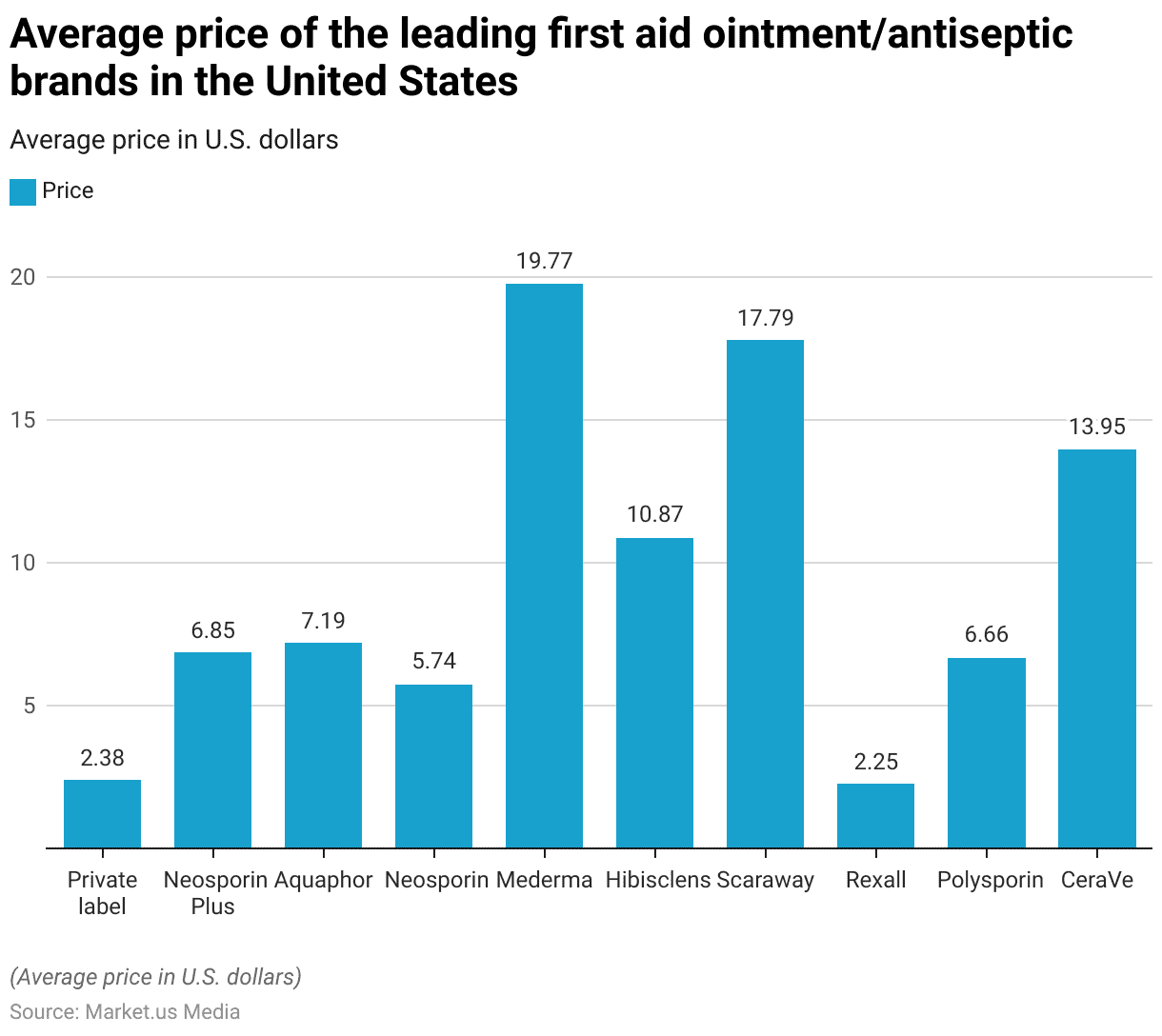
Key Spending and Investments
Worldwide Research and Development Spending in Medical Technology
- Worldwide research and development spending in the medical technology sector has shown a consistent upward trend from 2011 to 2024.
- In 2011, R&D investments totaled USD 23.4 billion, and this figure incrementally increased each year. Reflecting the growing emphasis on innovation in medical technologies.
- By 2012, spending slightly rose to USD 24.1 billion and continued to grow. Reaching USD 25 billion in 2013 and USD 25.6 billion in 2014.
- The trend persisted with an investment of USD 26 billion in 2015, which further escalated to USD 27.4 billion by 2016. The following year, 2017, saw a spending of USD 28.6 billion.
- Notably, the investment reached the USD 30 billion mark in 2018. Indicating significant progress and investment in the development of new medical technologies and treatments.
- This momentum was maintained over the following years, with spending reaching USD 31.3 billion in 2019, USD 32.8 billion in 2020, and USD 34.3 billion in 2021.
- The projections for the subsequent years indicate continued growth, with R&D spending expected to increase to USD 35.8 billion in 2022, USD 37.3 billion in 2023, and eventually reaching USD 38.9 billion by 2024.
- This steady rise in investment underscores the ongoing commitment to advancing medical technology. Aiming to enhance healthcare outcomes and develop innovative solutions for emerging health challenges.
(Source: Statista)
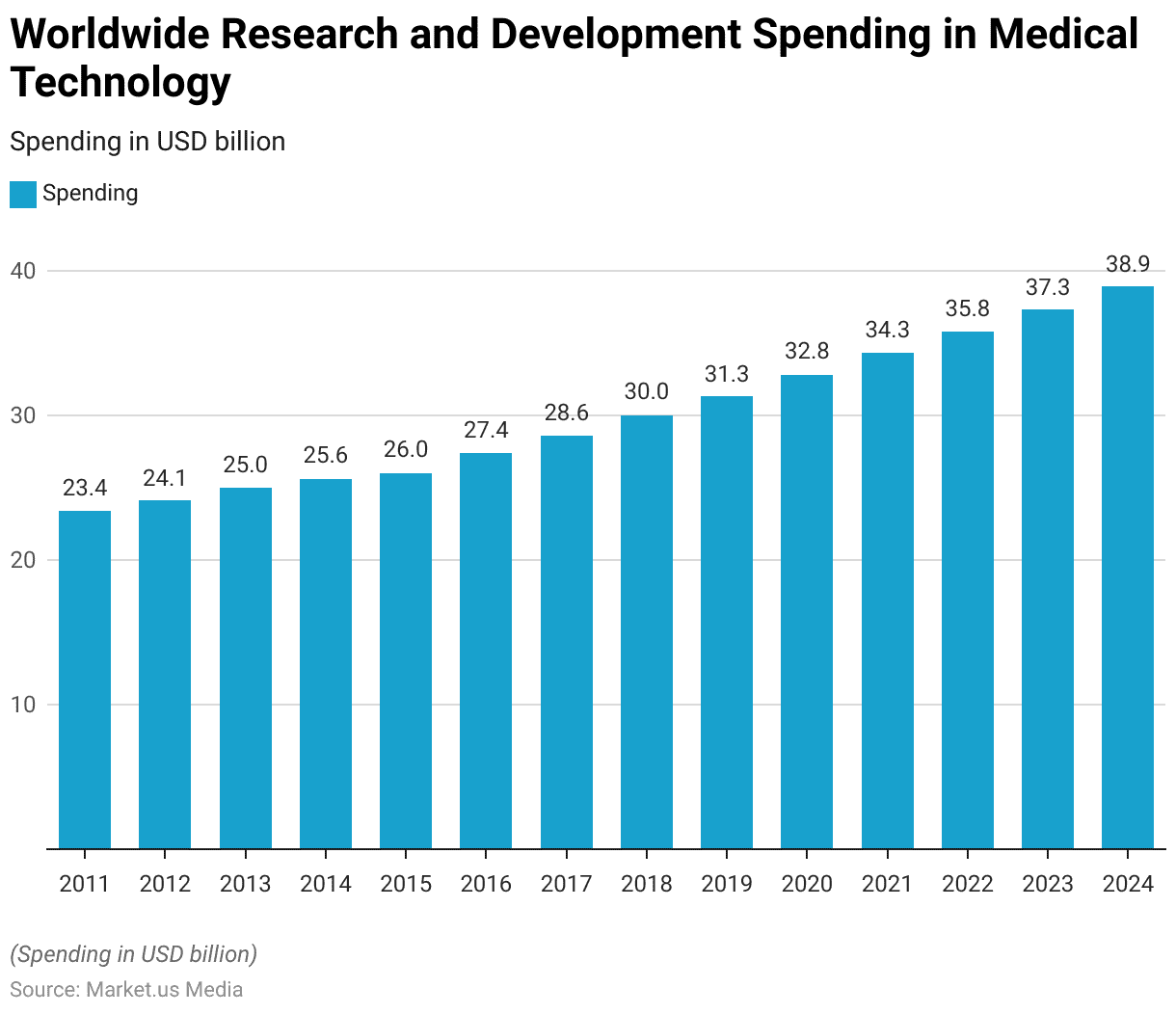
National Health Expenditure
- U.S. national health expenditure has seen a dramatic and consistent increase from 1960 to 2022. Reflecting the growing costs and expanding scope of healthcare services.
- In 1960, the expenditure was a mere $27.1 billion. Which escalated to $74.1 billion by 1970, showcasing an almost threefold increase over the decade.
- The growth continued through the following decades, with expenditure reaching $253.2 billion in 1980 and then more than doubled to $718.8 billion by 1990.
- Entering the new millennium, the expenditure had nearly doubled again, hitting $1,365 billion by the year 2000.
- This upward trend persisted into the 2000s, with expenditures reaching $2,025 billion by 2005, $2,164 billion in 2006, and continuing to grow each subsequent year. Reaching $2,305 billion in 2007, $2,402 billion in 2008, and $2,492 billion in 2009.
- By 2010, the total was $2,589 billion, demonstrating steady growth through the decade. The trend continued into the 2010s, with expenditures reaching $2,783 billion by 2012 and $3,002 billion in 2014, then climbing to $3,443.7 billion by 2017.
- The most recent years saw even more significant increases: $3,601.2 billion in 2018, $3,756.4 billion in 2019, and a notable jump to $4,156.3 billion in 2020, likely influenced by global health crises and inflationary pressures. The expenditure continued to rise, reaching $4,289.1 billion in 2021 and further increasing to $4,464.6 billion by 2022.
- This long-term trend underscores the escalating costs of healthcare in the U.S. and the challenges of managing healthcare expenditures effectively.
(Source: Statista)
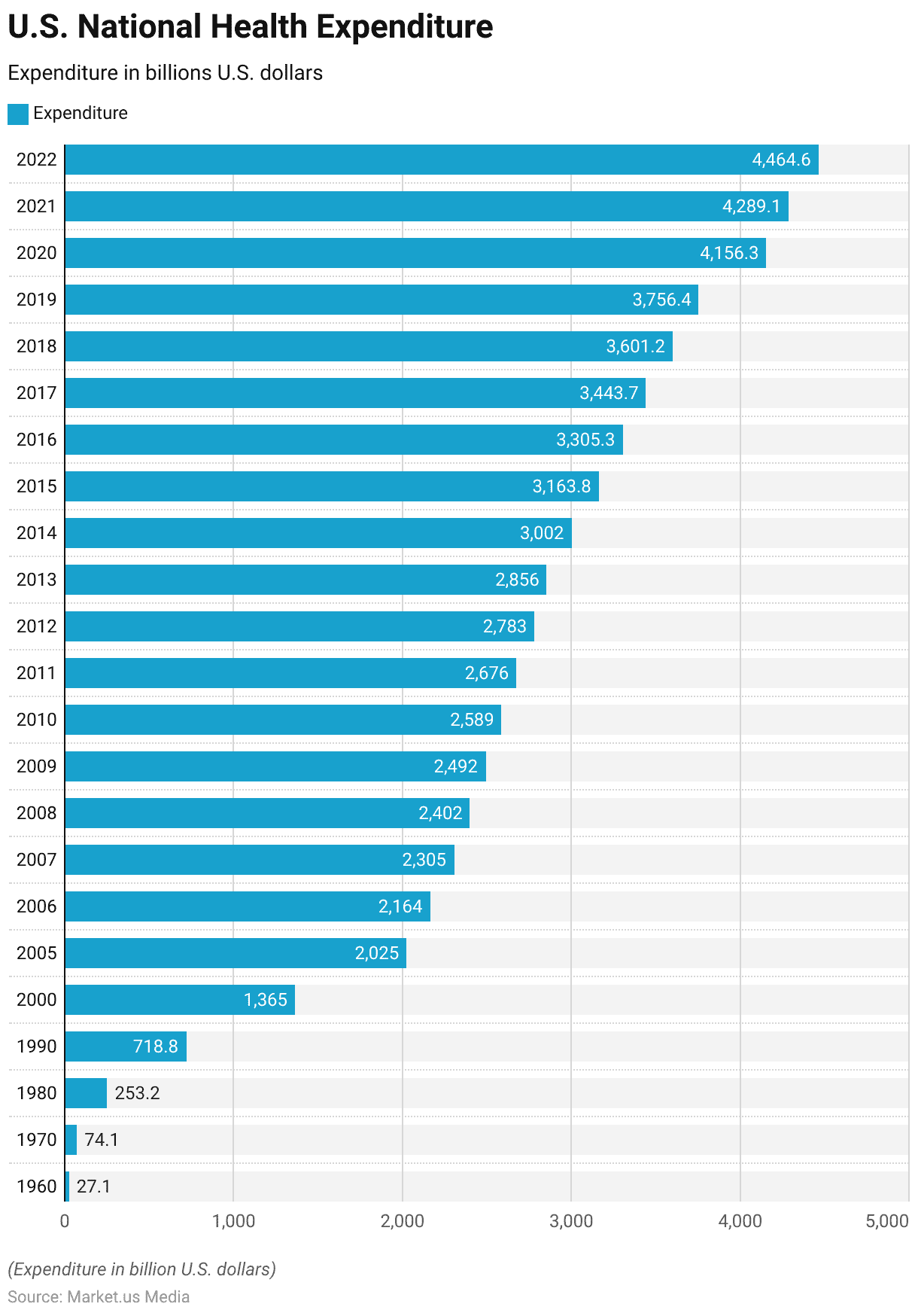
Private Healthcare Expenditure
- From 1997 to 2022, private healthcare expenditure in the United Kingdom showed a notable upward trend with some fluctuations.
- Starting at £14.3 billion in 1997, expenditure rose steadily over the years. Reaching £15.3 billion in 1998 and continuing to grow to £16 billion by 1999. This gradual increase continued through the early 2000s, with figures slightly varying. Peaking at £16.8 billion in 2001 before a slight dip to £16.6 billion in 2002.
- The mid-2000s witnessed a more substantial rise in private healthcare spending, with the amount reaching £19.9 billion by 2003.
- Although it slightly decreased to £19.8 billion in 2004, it stabilized at £19.9 billion in 2005 and then progressively increased to £21.5 billion in 2006. By 2007, expenditure had risen to £22.3 billion and saw a more significant jump to £24.7 billion in 2008.
- The late 2000s and early 2010s marked a period of continued growth, with expenditure peaking at £27.4 billion in 2009 and gradually increasing to £31.6 billion by 2013.
- The growth continued into the mid-2010s, with 2016 recording a slight plateau at £33.6 billion. However, the trend resumed with an increase to £35.4 billion in 2017. Reaching £38.7 billion in 2018 and further expanding to £41.3 billion in 2019.
- The year 2020 saw a slight decrease to £38.8 billion, likely influenced by economic contractions related to global events. But rebounded in 2021 to £42.5 billion and further to £46.4 billion by 2022.
- This progression underscores an increasing reliance on private healthcare funding within the UK over the 25 years. Reflecting broader shifts in healthcare financing and consumer behavior towards private health insurance and out-of-pocket spending.
(Source: market.us)
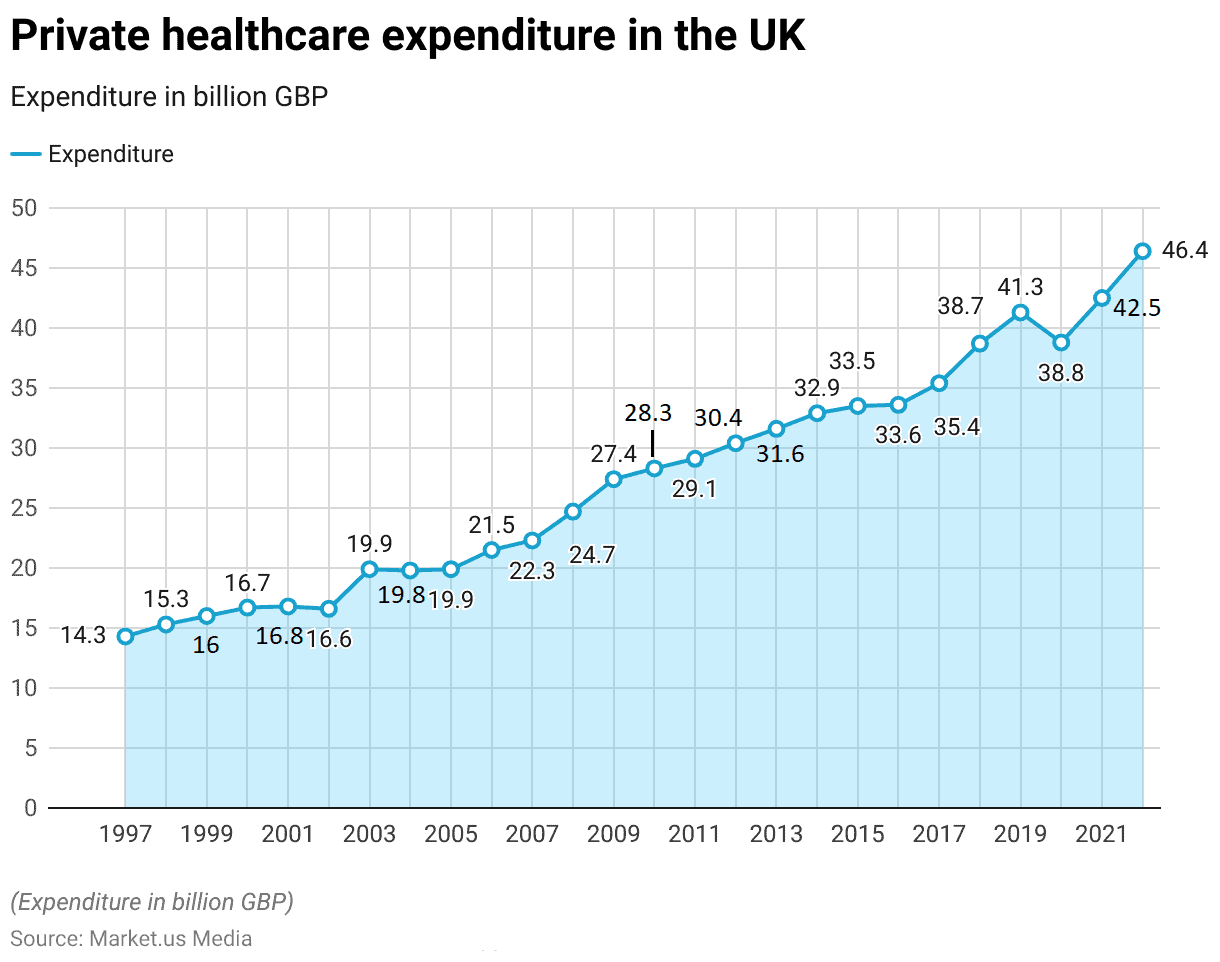
First Aid Regulations
- First aid regulations vary significantly by region, reflecting diverse legal requirements and workplace environments.
- In the United States, the Occupational Safety and Health Administration (OSHA) mandates specific standards for medical and first aid that apply across various sectors. Including general industry, maritime, and construction.
- For instance, OSHA requires adequate first aid supplies and training. Including cardiopulmonary resuscitation (CPR), in cases where there is a risk of sudden cardiac arrest. Standards are also set for the minimum contents of first aid kits, determined by potential workplace hazards.
- In Canada, WorkSafeBC has implemented updates to harmonize provincial regulations with national standards set by the Canadian Standards Association. Focusing particularly on high-risk and remote workplaces. Employers are given timelines to comply with these updated standards to facilitate smoother transitions and ensure preparedness.
- In the UK, the Health and Safety (First-Aid) Regulations 1981 require all employers to provide adequate first-aid equipment, facilities, and personnel. Adjusted based on a thorough assessment of first aid needs that considers the specific circumstances of the workplace.
- Meanwhile, Alberta’s OHS Code highlights recent changes in Part 11, which came into effect in 2023. Detailing provincial requirements that employers must meet to maintain compliance with first aid standards in the workplace.
- These examples illustrate the global emphasis on tailored first-aid provisions that consider both the nature of the work and specific environmental factors. Underscoring the importance of compliance to ensure worker safety across industries.
(Sources: ITU AbsorbTech, OSHA, Safety Alliance BC, OHS Resource Portal, HSE)
Recent Developments
Acquisitions and Mergers:
- 3M acquires KCI Medical: In 2023, 3M, a global leader in health and safety products, completed the acquisition of KCI Medical. A company specializing in wound care and first aid supplies, for $6.7 billion. This acquisition expands 3M’s portfolio in advanced wound care and first aid products. Allowing the company to better serve hospitals and first responders.
- Cardinal Health acquires Medline’s first aid division: In early 2024, Cardinal Health acquired Medline’s first aid and wound care division for $400 million. This deal aims to strengthen Cardinal Health’s presence in the first aid market. Providing more comprehensive solutions to healthcare providers and consumers.
New Product Launches:
- Johnson & Johnson introduces Smart First Aid Kit: In 2023, Johnson & Johnson launched its new Smart First Aid Kit. Which includes an app-based guide that walks users through the steps of basic first-aid procedures. The kit also features sensors that alert users when supplies are running low, to reduce first aid mistakes by 20%.
- First Aid Only debuts eco-friendly first aid kits: In mid-2023, First Aid Only, a leading provider of first aid kits, introduced a line of eco-friendly first aid kits. These kits are made from sustainable materials. Such as biodegradable bandages and recycled packaging, aligning with the growing demand for environmentally friendly products.
Funding:
- Stop the Bleed raises $15 million for educational initiatives: In 2023, Stop the Bleed, an organization dedicated to improving first aid education. Secured $15 million in funding to expand its educational programs in schools and workplaces. The initiative aims to train 1 million people annually in life-saving first aid techniques.
- QuickClot secures $25 million for advanced wound care products: In late 2023, QuickClot, a company specializing in hemostatic agents for emergency first aid. Raised $25 million to develop new wound care products that can stop bleeding faster and more effectively. The company plans to expand its product line to serve both military and civilian markets.
Technological Advancements:
- AI-powered first aid assistants: By 2025, it is estimated that 30% of first-aid kits will include AI-powered digital assistants to guide users through medical emergencies. Improving the accuracy of first-aid interventions.
- Wearable first aid monitoring devices: Wearable devices that monitor vital signs and alert users to injuries are gaining popularity. By 2026, 25% of wearable devices are expected to include first aid capabilities, particularly in workplaces and sports settings.
Conclusion
First Aid Statistics – In conclusion, first aid is essential in healthcare, providing immediate responses to emergencies and consistently growing in importance across individual and institutional settings.
The market for first aid products has evolved, reflecting advancements in medical technology and changing consumer needs, with both private labels and renowned brands striving to innovate.
Increased global healthcare expenditures, particularly in the U.S., highlight a broader trend toward health awareness and the prioritization of healthcare.
This trend influences the first aid market, emphasizing the crucial role of first aid in health and safety. Empowering individuals to act effectively in emergencies, and underscoring the ongoing commitment to innovation in medical care.
FAQs
First aid refers to the immediate care given to a person who has been injured or is suddenly ill before professional medical help arrives. Its primary goals are to preserve life, prevent further harm, and promote recovery.
A basic first aid kit should include items such as bandages, adhesive tape, antiseptic wipes, sterile gauze, scissors, tweezers, safety pins, ice packs, disposable sterile gloves, and pain relievers. It’s also recommended to include a list of emergency phone numbers.
To control bleeding, apply direct pressure to the wound with a clean cloth or bandage. If possible, elevate the injured area above the heart. Keep pressure on the wound until the bleeding stops or until you receive medical assistance.
Yes, workplace first aid kits typically need to adhere to specific regulations depending on the type of workplace and the hazards present. They often require more comprehensive supplies compared to a home kit.
For children, include child-appropriate medications, smaller bandages, and comfort items like stickers or small toys. A thermometer and pediatric electrolyte solution should also be considered.
Discuss your needs with our analyst
Please share your requirements with more details so our analyst can check if they can solve your problem(s)



